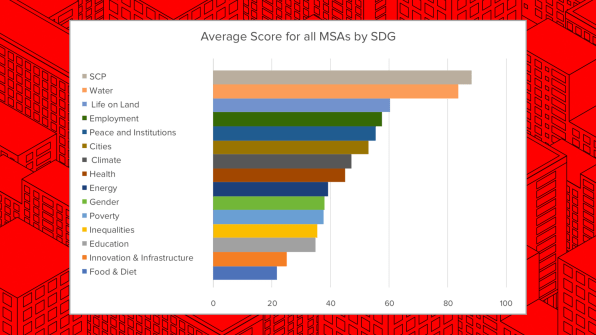American cities are failing on sustainable development
For clues about how America’s future is shaping up, look to its metro areas: They’re where 85% of the U.S. population lives, and where the bulk of the country’s economic and cultural activity unfurls.
But the picture they’re painting right now about where the country’s headed is pretty grim. In the second-annual analysis of how the 100 most populous U.S. cities and metro areas are faring in meeting the Sustainable Development Goals set out by the United Nations in 2015, the majority are lagging far behind. As many as 62 cities are less than half of the way toward making good on the 15 of the 17 SDGs that apply to urban areas. The best performing metro area, San Jose-Sunnyvale-Santa Clara (which also topped this list last year) is only 68% of the way toward meeting the SDGs for urban areas.
It’s important to note, says Jessica Espey, senior adviser for the Sustainable Development Solutions Network, which compiled the analysis, that this year’s analysis is not directly comparable to last years’. “We did change quite a few indicators either due to data quality concerns, or because we found better data,” says Espey, who coauthored the report. In that sense, the U.S. Cities Sustainable Development Goals Index should be viewed as an evolving reference document for cities that aggregates the most up-to-date data around the SDGs. “To the extent that we can, we will use replicable data every year so that we can look at comparisons over time,” Espey says, “but we know that the state of data available for many of these issues in America right now is pretty poor.” The report is designed to motivate cities to revamp their data collection efforts around the SDG categories, and also to work harder to meet the goals mandated by the UN.

As spotty as some of the data may be, though, some clear trends emerge in the second report. The main barriers to achieving the SDGs should be familiar to anyone who has spent time in an American city: poverty, racial inequity, climate inaction, and failure to provide healthy food to all residents. While these issues are not unique to cities in the U.S., there are certain aspects of American politics and culture that render them especially difficult to overcome, Espey says.
In terms of reducing inequality, for instance, none of the 100 U.S. metro areas in the report merited a “good performance” measure (each cities’ respective performance on the 15 measured SDGs is rated on a color-coded scale of four categories ranging from poor to good, with two moderate rankings in between). “Racial inequity is something we identified as a theme in every American city,” Espey says. When looking at differences between white and nonwhite groups in cities across America, “there’s acute differences in many outcomes–from poverty to health outcomes,” she adds. This is especially visible when looking at children’s outcomes. In all but one of the surveyed metro areas, child poverty rates were overall greater than poverty rates for the entire area, and in nine cities, they were 50% higher than overall poverty rates. Because child poverty rates tend to track with poor nutrition and health and economic difficulties later in life, it’s a foreboding statistic.
These inequities also suggest a failing on the part of many cities to make up for lagging state and federal policies around ending hunger and providing affordable housing and healthcare for all residents. “If you look at the correlation analysis we did, everything we did suggests that targeted supplemental support, particularly to the most vulnerable populations–children, the elderly, and marginalized racial and ethic groups–would be hugely beneficial, but it’s not something the federal government is doing at nearly a wide enough scale,” Espey says.
Also of note is a solid block of red–“poor performance”–under the climate action SDG category. Not one city scored above the lowest ranking, and this, Espey says, is because it’s measured in CO2 emissions per capita. “America’s got some of the highest CO2 emissions in the world,” she says. “Even the best-performing cities like San Jose are doing some great efforts around environmental protection and preservation, but they’re still completely car-dependent.” Cars are only one part of the problem, Espey adds, but the concentration of vehicle-related emissions in America’s cities must be drastically reduced if any want to climb out of the red.
Especially as federal policies remained paralyzed under the current administration, cities will be increasingly responsible for ensuring progress and the well-being of their residents and environments. America itself is ranked among the lowest of the wealthiest countries for overall performance on the SDGs–at number 42 worldwide–but progress in its urban areas could help pull it up. The SDG index can guide local politicians toward a better understanding of the factors they should be working to improve. “One of the most important things that cities should be doing is shining a spotlight on many of the issues the federal government won’t talk about or address,” Espey says. The annual index sums up what those issues are.
(41)



